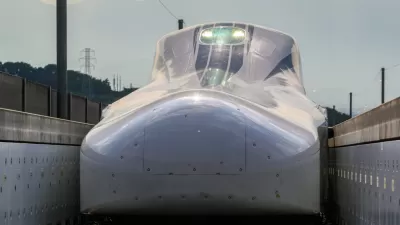This article from the San Francisco Chronicle argues it's time for a national rail plan.
"Here are some of the hard truths about the future of rail service in the United States:"
"The basic idea has merit: Trains use less energy per passenger mile than jet airplanes, especially on shorter trips. Even a major switch wouldn't make a huge dent in national oil use or cut total energy consumption. But an improved rail system could cut use of oil substantially: Electrically driven trains can run on no-oil coal and nuclear power."
"Sadly, most of Amtrak's current system doesn't help cut either energy or oil use much. Amtrak was conceived, in a political process, as a 'nationwide passenger railroad network.' As implemented, that resulted in a series of daily or less-than-daily long-haul trains, traveling at less-than-highway (or less than 1948 rail) speeds, each carrying, at best, the equivalent of maybe two 737s full of people."
"Where Amtrak does do well is in the Northeast corridor. Its frequent and (relatively) high-speed trains between New York and Washington command a significant and growing share of the market."
"What these facts tell me is that a rational national rail policy should concentrate on high-speed service in corridors linking major cities fewer than 400 miles apart."
FULL STORY: All aboard for a rational national rail plan

Planetizen Federal Action Tracker
A weekly monitor of how Trump’s orders and actions are impacting planners and planning in America.

Chicago’s Ghost Rails
Just beneath the surface of the modern city lie the remnants of its expansive early 20th-century streetcar system.

San Antonio and Austin are Fusing Into one Massive Megaregion
The region spanning the two central Texas cities is growing fast, posing challenges for local infrastructure and water supplies.

Since Zion's Shuttles Went Electric “The Smog is Gone”
Visitors to Zion National Park can enjoy the canyon via the nation’s first fully electric park shuttle system.

Trump Distributing DOT Safety Funds at 1/10 Rate of Biden
Funds for Safe Streets and other transportation safety and equity programs are being held up by administrative reviews and conflicts with the Trump administration’s priorities.

German Cities Subsidize Taxis for Women Amid Wave of Violence
Free or low-cost taxi rides can help women navigate cities more safely, but critics say the programs don't address the root causes of violence against women.
Urban Design for Planners 1: Software Tools
This six-course series explores essential urban design concepts using open source software and equips planners with the tools they need to participate fully in the urban design process.
Planning for Universal Design
Learn the tools for implementing Universal Design in planning regulations.
planning NEXT
Appalachian Highlands Housing Partners
Mpact (founded as Rail~Volution)
City of Camden Redevelopment Agency
City of Astoria
City of Portland
City of Laramie





























